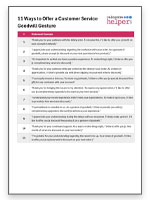Goodwill gestures play a crucial role in customer service, as they can significantly influence customer satisfaction and loyalty.
These gestures don’t always need to involve monetary compensation; often, a thoughtful, personalized approach can effectively mend relationships damaged by negative experiences.
With this in mind, we asked our panel of experts for their best goodwill gestures that can be used to build better customer relationships.
What is Meant By Goodwill Gesture?
In customer service, particularly in contact centres or call centres, a “goodwill gesture” refers to an action taken by a representative to demonstrate goodwill toward a customer.
This typically occurs in response to a customer complaint, inconvenience, or negative experience. The aim is to rebuild trust, show appreciation, or apologize for any dissatisfaction.
Examples include:
- Offering discounts, refunds, or free products/services to resolve an issue.
- Going above and beyond to address a customer’s specific concerns.
- Checking in with the customer after an issue has been resolved to ensure satisfaction.
- Providing exclusive deals or perks to loyal customers.
These gestures are intended to enhance customer satisfaction, strengthen relationships, and encourage continued business.
11 Examples of Goodwill Gestures for Customer Service
When bad things happen, seize the opportunity to show your humanity and dedication to your customers in real, meaningful ways.
Here are some useful suggestions for what you could use as goodwill gestures:
1. Offer to Give Compensation to Charity

Often, people do want monetary compensation to fix the damage caused by a negative experience, but a goodwill gesture that could be offered instead is a donation to charity.
The customer could choose the charity they would like the donation to go to, or the brand could offer a choice of charities they support.
It would then be the customer’s choice whether they receive money back or if the money goes to charity. It is a gesture that not only shows a company cares, but it is also a way to pay things forward.
Contributed by: Walt Weisner, Chief Customer Officer, 8×8
2. In-Post Surprises

Perhaps some of the most powerful goodwill gestures are the ones people don’t expect — genuine, thoughtful and not for any immediate goal, like making amends.
Discount codes and service promises are great but they require further time or financial input from a customer.
However, your business still directly profits from this type of generosity. When something physical arrives unexpectedly in the post, it’s a little thinking-of-you moment that makes customers feel valued.
3. Gestures With Real-Life Value
Often when resolving a problem, customers will tell you exactly what they want. Meeting those expectations is a quick way to defuse a situation by giving them what holds the most value.
However, if this amounts to something small like a £1.23 refund, turn it into a gift with real-life value.
For example, an automatic 10% discount off their next monthly bill on a contracted service. Or there may be a product or service which could be discounted or offered as a trial based on customer knowledge.
Even your own business can benefit from this, but your customer chose you for a reason. Why not reinforce the value of your products and offer them real value at the same time?
Contributed by: Juliet Fehr, UK Head of Odigo Experience Services, Odigo
4. Loyalty Programmes

Offer access to a loyalty programme where customers can access discounts, flash sales, loyalty prizes, free shipping, etc.
5. Seek Actionable Feedback
Make changes based on feedback and advertise these changes with messaging that shows how customer input influenced this new direction.
6. Thank-You Notes or Emails
Simple, yet effective, a personal thank-you note or email means customers feel heard and appreciated.
7. Give to a Cause the Customer Espouses
This doesn’t have to mean money, it may be time that you can free up for you and your team to volunteer.
8. Offer a Free Service
Something that you could monetize but will provide to your customer free of charge. An example is Loom’s removal of a recording limit on their sharable video software.
- Promote their business on your website/blog/social media
- Provide an early upgrade
Contributed by: Caroline Leonard, Head of Marketing, Spearline
9. Discount and Free Delivery
A friend of mine recently got a 10% discount code and free delivery on their next order after complaining about a delayed parcel.
Contributed by: Megan
10. Money Off
I once got money off my internet bill as I kept getting drop-outs – it didn’t fix the problem but did help calm me down when I was feeling frustrated.
Contributed by: Rachael
11. Free Product or Service
Free overnight shipping, upgraded product, a percentage off the current or next order or both, and in some cases, a free product.
Contributed by: Michael
Top Tips to Create Effective Goodwill Gestures for Customers
Our experts also provided some top advice on what to consider when putting together a goodwill gesture for your customers:
Surprise Customers and Overdeliver on Your Promise

Customer experience is all about meeting and exceeding expectations throughout the entire customer journey. Just one negative experience can damage customer loyalty and can be challenging to fix.
Surprise your customers, as part of a strategy to rebuild the relationship, and overdeliver on your promise.
You can offer a complimentary service or product discount that your customer wouldn’t normally expect. For example, a hospitality company could offer a complimentary meal or a generous discount on a guest’s next booking.
Even if you have apologized and fixed your mistake, going the extra mile will show your dedication and appreciation to your customers.
Contributed by: Sabine Winterkamp, Vice President, International Marketing, Five9
Don’t Use Blanket Gestures

In a world where customers have significant power, blanket gestures no longer have the effect organizations desire – customers expect more. Gestures should reflect both the customer as an individual and the scale of the issue they experienced.
When it comes to the scale of the issue, you should consider the original impact made on the customer and any costs they may have incurred.
For gestures, ensuring they are personalized is key. Engage with the team member(s) who handled the issue as part of the decision-making process, as their experience with the customer is an asset.
They should know a bit about the customer’s lifestyle and how the issue has impacted them, allowing them to understand what will land well and ensuring that the gesture is meaningful.
Contributed by: Drew Naylor, Product Owner, MaxContact
Make It Personal

Customer satisfaction is more important than ever before. A great customer experience builds brand advocacy and continued loyalty, but a bad one can have the opposite effect.
Dissatisfied customers can spread negative sentiment at lightning speed thanks to the number of online channels now available.
That’s why it’s important to make customers feel valued in order to enhance loyalty and build positive relationships.
Customer loyalty is often multifaceted, and delivering personalized experiences is one way to show customers you care about them individually.
Using technology such as conversation intelligence can allow you to build data-driven loyalty schemes based on customer behaviours and preferences.
When customers feel valued and understood, as well as receiving experiences that are specific to them, they’re likely to be more loyal and even expand the business they do with your brand.
Contributed by: Frank Sherlock, VP International, CallMiner
Think Proactive and Predictive

A goodwill gesture can be delivered through proactive, predictive and seamless interactions.
Imagine you’re getting ready to fly across the country. Before leaving home, you receive a proactive text message from the airline: your flight is cancelled. The text asks if you’d like to reschedule. You respond with “I want to fly out as soon as possible”.
With proactive, predictive messages, the airline understands what you’re asking and responds with a booking link as well as a voucher code.
While the traveller is booking the new flight on the website, they can chat with a bot that can tell them how to redeem the voucher.
At any point the bot can seamlessly transfer them to an employee for further assistance, picking up exactly where the conversation left off.
This is not only seamless and proactive, but eliminates the opportunity for error or misunderstanding, keeping the traveller informed, happy and appreciated.
Contributed by: Elizabeth Tobey, Head of Marketing Digital Solutions, NiCE
How to Offer a Customer Service Goodwill Gesture
Offering a gesture of goodwill can help strengthen relationships and show appreciation or apology, so here are some steps you should take to make sure you are getting it right:
Step 1: Listen Actively
Engage with the customer by giving them your full attention. Allow them to express their concerns fully without interruptions.
Use non-verbal cues, such as nodding or affirming sounds, to show that you’re genuinely interested. This approach helps build rapport and demonstrates that you value their perspective.
Step 2: Apologize Sincerely
Acknowledge the customer’s feelings by offering a heartfelt apology for the inconvenience they have experienced.
This step is crucial in validating their emotions and making them feel heard. A sincere apology can help diffuse tension and set a positive tone for the conversation moving forward.
Step 3: Assess the Situation
Take a moment to evaluate the specific issue at hand. Consider the details of the customer’s complaint as well as their history with your company.
Understanding their situation enables you to tailor your response and choose the most appropriate goodwill gesture, ensuring it aligns with their needs.
Step 4: Offer a Gesture
Once you’ve assessed the situation, present a gesture of goodwill that addresses the customer’s concerns.
This could involve providing a form of compensation or an added benefit. Clearly communicating your intention behind the gesture reinforces that you care about their satisfaction and are dedicated to resolving the issue.
Example Phrases to Use When Offering a Goodwill Gesture to a Customer
Here are a few examples of what you might say to a customer when offering a gesture of goodwill:
- “Thank you for your patience with the billing error. To resolve this, I’d like to offer you a [credit on your account/a refund].”
- “I appreciate your understanding regarding the confusion with your order. As a gesture of goodwill, please accept [a discount on your next purchase/a free product].”
- “It’s important to us that you have a positive experience. To make things right, I’d like to offer you [a complimentary service/a discount].”
- “Thank you for your patience while we sorted out the delay in your order. As a token of appreciation, I’d like to provide you with [free shipping on your next order/a discount].”
- “Your loyalty means a lot to us. To show my gratitude, I’d like to offer you [a special discount/free gift] for any confusion with your account.”
- “Thank you for bringing the issues to my attention. To express my appreciation, I’d like to offer you [a complimentary upgrade/a discount on your next service].”
- “I understand your recent experience didn’t meet your expectations. To make it up to you, I’d like to provide [a free service/a discount].”
- “Your feedback is valuable to us. As a gesture of goodwill, I’d like to provide you with [a complimentary upgrade/a discount] to enhance your experience.”
- “I appreciate your understanding during the delays with our response. To help make up for it, I’d like to offer you [a discount/free product] as a gesture of goodwill.”
- “Thank you for your continued support. As a way to make things right, I’d like to offer you [a free month of service/a discount on your next order].”
- “I’m grateful for your understanding regarding the recent mix-up. As a token of goodwill, I’d like to offer you [a replacement/a discount on your next order].”
Printable – 11 Ways to Offer a Customer Service Goodwill Gesture
Do you want to download this to share with your team?
Get your free download of 11 Ways to Offer a Customer Service Goodwill Gesture now:
Step 5: Follow Up
After addressing the customer’s issue and offering your goodwill gesture, reassure them that you’re available for any future questions or concerns.
This step is important for building ongoing trust and demonstrates your commitment to customer care. A follow-up reinforces the relationship and encourages the customer to reach out if they need further assistance.
For more great insights and advice from our panel of experts, read these articles next:
- The Best De-Escalation Techniques
- Technology to Make Managing a Contact Centre Easier
- How to Build Flexible Schedules in the Contact Centre
- Tools and Techniques to Boost Advisor Productivity
Author: Megan Jones
Reviewed by: Robyn Coppell
Published On: 20th Feb 2023 - Last modified: 22nd Oct 2025
Read more about - Customer Service Strategy, 8x8, CallMiner, Caroline Leonard, Complaints, Customer Engagement, Customer Experience (CX), Drew Naylor, Elizabeth Tobey, Five9, Frank Sherlock, Free Downloads, Juliet Fehr, MaxContact, NiCE, NiCE CXone, Odigo, Sabine Winterkamp, Service Strategy, Spearline, Walt Weisner






















